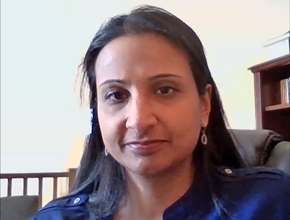Dr Simon Oczkowski, assistant professor in the Department of Medicine at McMaster University, expert in critical care medicine, and author of transfusion clinical practice guidelines, talks with Dr Roman Jaeschke about the new European Society of Intensive Care Medicine (ESICM) guidelines on transfusions in the critically ill.
References
Vlaar AP, Oczkowski S, de Bruin S, et al. Transfusion strategies in non-bleeding critically ill adults: a clinical practice guideline from the European Society of Intensive Care Medicine. Intensive Care Med. 2020 Jan 7. doi: 10.1007/s00134-019-05884-8. [Epub ahead of print] PubMed PMID: 31912207.Roman Jaeschke, MD, MSc: Good afternoon. Welcome to another edition of McMaster Perspective. I want to introduce to you Doctor Simon Oczkowski, who participated in the newly released guidelines from the European Society of Intensive Care Medicine (ESICM) on the transfusion of blood and blood products [see Publications of the Week, February 17]. These are European guidelines but I saw 3 authors from McMaster, so we felt that this could be featured in McMaster Perspective.
Simon, give us some general comments about those guidelines. Anything changed? Anything new? Anything people should know?
Simon Oczkowski, MHSc, MSc, MD: These guidelines came out of a request from the intensive care community in Europe, from the ESICM, with a recognition that the intensive care population has a huge variety of patients from cardiac surgery, neurosurgery, patients with coronary disease, patients with sepsis. Recognizing that huge variety of patients that we care for and that a one-size-fits-all approach to transfusion may not be appropriate, there was a need for clinical practice guidelines that could help clinicians to address specific patient populations that they care for. So this is looking towards providing a slightly more tailored, patient-specific approach to transfusion in the intensive care unit (ICU).
Roman Jaeschke: Historically, what has changed?
Simon Oczkowski: When you look at the guidelines from years ago up to now, I think the big things that have changed is that we’re increasingly seeing a reduction in the use of blood products in a move from a liberal transfusion strategy towards a restrictive one. This is true whether you’re looking at a red blood cell transfusion or a platelet or plasma transfusion; all of these in a setting of nonbleeding patients, I should add. In general, we’re transfusing less and being more conservative in our approach.
Roman Jaeschke: If you were to provide people with some general statements about the threshold, where is it and are there exceptions?
Simon Oczkowski: In the past 10 or 15 years there’s been a number of randomized trials that have come out, evaluating different transfusion thresholds in critically ill patients. The landmark TRICC (Transfusion Requirements in Critical Care) trial that was done by the Canadian Critical Care Trials Group demonstrated that in a mixed ICU population a restrictive transfusion threshold of 7 g/dL appeared to be safe.
Since that time newer studies have looked at specific patient populations; I’m thinking about studies like TRISS (Transfusion Requirements in Septic Shock), which looked at patients with septic shock; or TITRe2 (Transfusion Indication Threshold Reduction) and TRICS III (Transfusion Requirements in Cardiac Surgery III) trials, which looked at cardiac surgery. In general, the transfusion strategies that have been studied are looking at a restrictive transfusion threshold of ~7 g/dL, maybe 7.5 g/dL, and comparing those with a liberal transfusion threshold anywhere from ~9 g/dL to 10 g/dL.
In general, what we’re seeing across most of these patient populations is that a restrictive transfusion threshold ~7 g/dL appears to be safe, in some cases even beneficial, compared to a more liberal transfusion strategy. That being said, the evidence base guiding these decisions in these very specific patient populations is still evolving.
There’re really only 2 areas where the guideline panel felt comfortable issuing a strong recommendation with regard to red blood cell transfusion thresholds. Those 2 populations were, first, a general ICU population represented by patients from studies like TRICC and TRISS studies; the rationale for making a strong recommendation in this general, unselected ICU population was that when you look at clinical practice patterns around the world, most places are using 7 g/dL as their baseline for transfusing red blood products. If you look at that evidence now…
Roman Jaeschke: It appears that 70 g/L [= 7 g/dL] for the nonbleeding population may be a way to go. What are the exceptions involved, if any?
Simon Oczkowski: The other area where we have a lot of certainty would be in cardiac surgery, where we also issued a strong recommendation.
But there’re a few areas worthy of caution, where we issued conditional recommendations. These would be for a liberal transfusion strategy, which may be beneficial in patients with acute coronary syndromes. There’s a small number of studies there…
Roman Jaeschke: Liberal?
Simon Oczkowski: Yes, liberal. In patients with acute coronary syndromes a liberal transfusion strategy might be beneficial, although we had low certainty of evidence for that recommendation. There are several studies ongoing…
Roman Jaeschke: Liberal meaning 90 g/L [= 9 g/dL]?
Simon Oczkowski: Anywhere from 9 g/dL up to 10 g/dL. When you look at clinical practice patterns, in general that is what clinicians are doing. So most people are aware that in this patient population there’s at least a physiologic rationale for a higher transfusion threshold.
Roman Jaeschke: If you don’t mind me asking, are there any controversial areas? Anything lots of discussions were spent on?
Simon Oczkowski: There is a lot of discussion about some of the very specific populations in the ICU. The ones I’m thinking about in particular were the ones where we were unable to come to a consensus recommendation about what the appropriate transfusion thresholds were. Those populations were patients with acute neurologic injuries, such as stroke or intracranial hemorrhage from a subarachnoid aneurysm; patients who are on extracorporeal membrane oxygenation (ECMO); and there were concerns as well about very elderly patients who are increasingly a part of the critically ill population. At what age do these restrictive transfusion thresholds continue to apply, recognizing that older patients often have a greater burden of atherosclerotic disease but at the same time perhaps also less ability to withstand the high volumes of fluid that are transfused along with these red blood cells? Those were identified in the areas of high priority of research in the future.
Roman Jaeschke: So how should we behave in the meantime?
Simon Oczkowski: Recognizing that we didn’t feel comfortable making clinical practice recommendations stating that a transfusion threshold at a specific level would be superior, what the panel decided to do was to describe the literature that does exist—usually those were observational or pilot studies—that compared varying transfusion thresholds in those populations. What we ended up doing was describing what are the transfusion thresholds that have been studied.
When clinicians read the guideline document, we don’t say that a liberal is better than a restrictive transfusion threshold, but at the very least we’re providing a range of thresholds that has been studied. If clinicians are transfusing at one of those thresholds, they can feel confident that at least they’re maintaining something that is close to a standard of care and it’s reasonable to be used in a research setting.
 English
English
 Español
Español
 українська
українська










